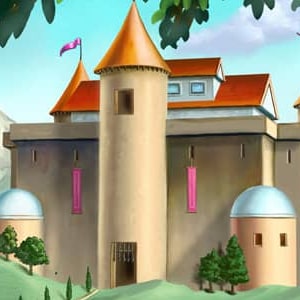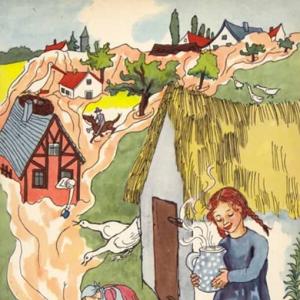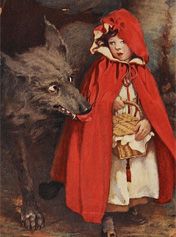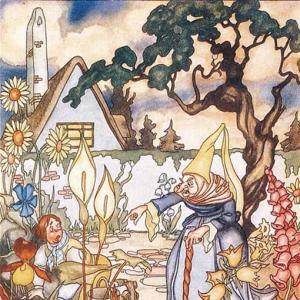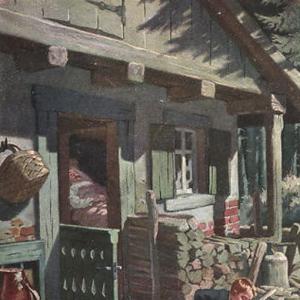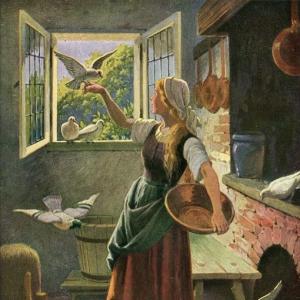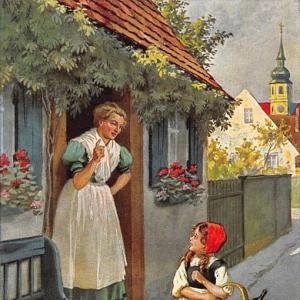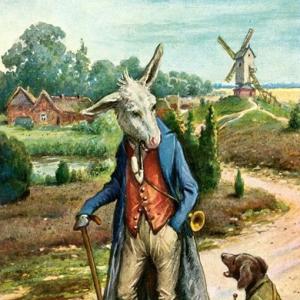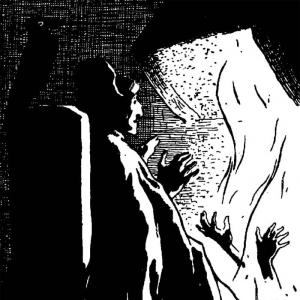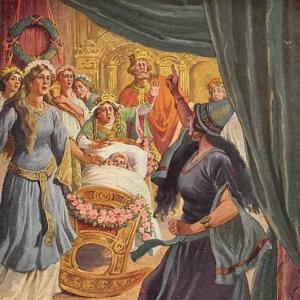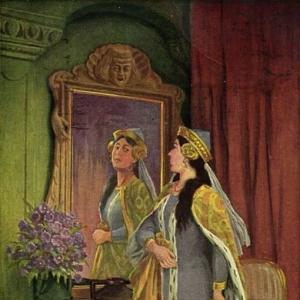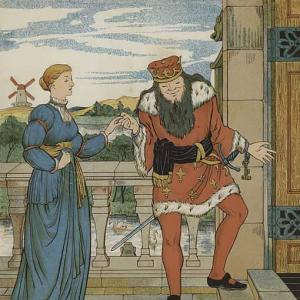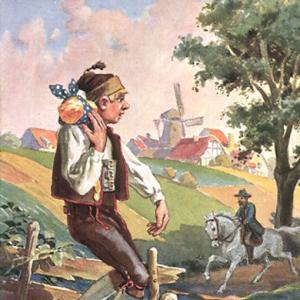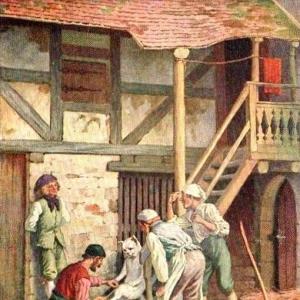Reading time for children: 10 min
There was once a poor shepherd-boy whose father and mother were dead, and he was placed by the authorities in the house of a rich man, who was to feed him and bring him up. The man and his wife, had however, bad hearts, and were greedy and anxious about their riches, and vexed whenever any one put a morsel of their bread in his mouth. The poor young fellow might do what he liked, he got little to eat, but only so many blows the more. One day he had to watch a hen and her chickens, but she ran through a quick-set hedge with them, and a hawk darted down instantly, and carried her off through the air. The boy called, „Thief! thief! rascal!“ with all the strength of his body. But what good did that do? The hawk did not bring its prey back again. The man heard the noise, and ran to the spot, and as soon as he saw that his hen was gone, he fell in a rage, and gave the boy such a beating that he could not stir for two days. Then he had to take care of the chickens without the hen, but now his difficulty was greater, for one ran here and the other there. He thought he was doing a very wise thing when he tied them all together with a string, because then the hawk would not be able to steal any of them away from him. But he was very much mistaken. After two days, worn out with running about and hunger, he fell asleep. The bird of prey came, and seized one of the chickens, and as the others were tied fast to it, it carried them all off together, perched itself on a tree, and devoured them. The farmer was just coming home, and when he saw the misfortune, he got angry and beat the boy so unmercifully that he was forced to lie in bed for several days.
When he was on his legs again, the farmer said to him, „Thou art too stupid for me, I cannot make a herdsman of thee, thou must go as errand-boy.“ Then he sent him to the judge, to whom he was to carry a basketful of grapes, and he gave him a letter as well. On the way hunger and thirst tormented the unhappy boy so violently that he ate two of the bunches of grapes. He took the basket to the judge, but when the judge had read the letter, and counted the bunches he said, „Two clusters are wanting.“ The boy confessed quite honestly that, driven by hunger and thirst, he had devoured the two which were wanting. The judge wrote a letter to the farmer, and asked for the same number of grapes again. These also the boy had to take to him with a letter. As he again was so extremely hungry and thirsty, he could not help it, and again ate two bunches. But first he took the letter out of the basket, put it under a stone and seated himself thereon in order that the letter might not see and betray him. The judge, however, again made him give an explanation about the missing bunches. „Ah,“ said the boy, „how have you learnt that?“ The letter could not know about it, for I put it under a stone before I did it.“ The judge could not help laughing at the boy’s simplicity, and sent the man a letter wherein he cautioned him to keep the poor boy better, and not let him want for meat and drink, and also that he was to teach him what was right and what was wrong.
„I will soon show thee the difference,“ said the hard man, „if thou wilt eat, thou must work, and if thou dost anything wrong, thou shalt be quite sufficiently taught by blows.“
The next day he set him a hard task. He was to chop two bundles of straw for food for the horses, and then the man threatened: „In five hours,“ said he, „I shall be back again, and if the straw is not cut to chaff by that time, I will beat thee until thou canst not move a limb.“ The farmer went with his wife, the man-servant and the girl, to the yearly fair, and left nothing behind for the boy but a small bit of bread. The boy seated himself on the bench, and began to work with all his might. As he got warm over it he put his little coat off and threw it on the straw. In his terror lest he should not get done in time he kept constantly cutting, and in his haste, without noticing it, he chopped his little coat as well as the straw. He became aware of the misfortune too late. There was no repairing it. „Ah,“ cried he, „now all is over with me! The wicked man did not threaten me for nothing. If he comes back and sees what I have done, he will kill me. Rather than that I will take my own life.“
The boy had once heard the farmer’s wife say, „I have a pot with poison in it under my bed.“ She, however, had only said that to keep away greedy people, for there was honey in it. The boy crept under the bed, brought out the pot, and ate all that was in it. „I do not know,“ said he, „folks say death is bitter, but it tastes very sweet to me. It is no wonder that the farmer’s wife has so often longed for death.“ He seated himself in a little chair, and was prepared to die. But instead of becoming weaker he felt himself strengthened by the nourishing food. „It cannot have been poison,“ thought he, „but the farmer once said there was a small bottle of poison for flies in the box in which he keeps his clothes; that, no doubt, will be the true poison, and bring death to me.“ It was, however, no poison for flies, but Hungarian wine. The boy got out the bottle, and emptied it. „This death tastes sweet too,“ said he, but shortly after when the wine began to mount into his brain and stupefy him, he thought his end was drawing near. „I feel that I must die,“ said he, „I will go away to the churchyard, and seek a grave.“ He staggered out, reached the churchyard, and laid himself in a newly dug grave. He lost his senses more and more. In the neighbourhood was an inn where a wedding was being kept. When he heard the music, he fancied he was already in Paradise, until at length he lost all consciousness. The poor boy never awoke again. The heat of the strong wine and the cold night-dew deprived him of life, and he remained in the grave in which he had laid himself.
When the farmer heard the news of the boy’s death he was terrified, and afraid of being brought to justice indeed, his distress took such a powerful hold of him that he fell fainting to the ground. His wife, who was standing on the hearth with a pan of hot fat, ran to him to help him. But the flames darted against the pan, the whole house caught fire, in a few hours it lay in ashes, and the rest of the years they had to live they passed in poverty and misery, tormented by the pangs of conscience.
 Learn languages. Double-tap on a word.Learn languages in context with Childstories.org and Deepl.com.
Learn languages. Double-tap on a word.Learn languages in context with Childstories.org and Deepl.com.Backgrounds
Interpretations
Adaptions
Summary
Linguistics
„The Poor Boy in the Grave“ is a German fairy tale collected by the Brothers Grimm, who were famous for their collection of German and European folklore. The tale was first published in the early 19th century, as part of the Grimm’s anthology „Kinder- und Hausmärchen“ (Children’s and Household Tales). The Brothers Grimm, Jacob and Wilhelm, were scholars and linguists who dedicated their lives to collecting and preserving traditional stories that were passed down through generations.
Their collection of tales, published in multiple volumes, is one of the most well-known and influential works in Western folklore. Some of the most popular stories, such as Cinderella, Snow White, and Hansel and Gretel, have become ingrained in popular culture and inspired countless adaptations in literature, film, and other media.
The Brothers Grimm were part of the larger Romantic movement in Europe, which emphasized a return to tradition, folklore, and national identity. The tales they collected were intended to serve as a cultural and historical record, capturing the unique spirit of German and European oral storytelling.
In addition to being literary figures, the Brothers Grimm were also academics, working as professors and researchers. Their work in linguistics, particularly in the study of the German language, is still considered significant today. Their collection of fairy tales, along with their academic pursuits, helped to cement their reputation as important figures in the study of folklore and the development of the modern study of folklore and cultural anthropology.
„The Poor Boy in the Grave“ can be interpreted in several ways, including as a cautionary tale, a critique of social inequality, and an exploration of the consequences of abuse and neglect.
Cautionary tale: The story serves as a warning against greed, cruelty, and neglect. The rich farmer and his wife’s mistreatment of the poor boy ultimately leads to their own downfall, as they lose their wealth and live the rest of their lives in misery. This demonstrates the importance of treating others with kindness and compassion, and that negative actions can have serious consequences.
Critique of social inequality: The story highlights the disparity between the rich and the poor, and the injustices faced by the less fortunate. The poor boy, an orphan placed in the care of the wealthy farmer, is subject to abuse and neglect, despite the judge’s order to provide better care for him. This emphasizes the need for greater social awareness and support for vulnerable individuals in society.
Consequences of abuse and neglect: The tale serves as a tragic exploration of the impact of abuse and neglect on a young and vulnerable person. The boy, tormented by his caretakers, feels he has no choice but to end his life. His tragic fate, along with the eventual ruin of the farmer and his wife, demonstrates the destructive nature of abuse and the importance of compassion and care for those in need.
Overall, „The Poor Boy in the Grave“ is a powerful story that teaches valuable lessons about the significance of kindness, empathy, and the consequences of mistreatment. It also encourages readers to be more aware of social inequality and the plight of vulnerable individuals in society.
„The Poor Boy in the Grave“ is a popular fairy tale that has been adapted in various forms across different cultures and media. Here are a few examples of adaptations of the story.
„The Three Wishes“ by Joseph Jacobs: This is an English version of the tale, in which a poor woodcutter is granted three wishes by a fairy. The woodcutter’s third wish leads him to the grave, where he must complete a series of tasks to earn a magic herb that can save his dying wife.
„The Good-for-Nothing“ by Hans Christian Andersen: This is a Danish version of the tale, in which a lazy and selfish boy sets out to find a cure for his sick mother. He encounters a series of challenges and ultimately learns the value of hard work and compassion.
„The Grave of the Fireflies“ (1988): This is a Japanese anime film that is loosely based on the tale. The film follows two siblings who are struggling to survive in Japan during World War II. They encounter a series of challenges and tragedies, including the death of their mother, and must rely on each other to survive.
„Hansel and Gretel“ by the Brothers Grimm: This classic fairy tale shares several similarities with „The Poor Boy in the Grave“, including the themes of poverty, perseverance, and the supernatural. In both stories, the main characters must navigate a dangerous and unfamiliar world to overcome their challenges and ultimately find a way to save themselves or their loved ones.
Overall, „The Poor Boy in the Grave“ has inspired numerous adaptations and variations, each with their own unique twists and interpretations. The story’s enduring themes and universal appeal have made it a beloved classic across different cultures and media.
The Poor Boy in the Grave“ is a Brothers Grimm fairy tale about a young shepherd boy who suffers at the hands of a cruel, rich farmer and his wife. The farmer is ordered by a judge to provide better care for the boy, but instead, the farmer threatens and mistreats him even more.
One day, the farmer tasks the boy with chopping straw for the horses and warns him of a severe beating if the task is not completed in five hours. Left with a small piece of bread, the boy works diligently but accidentally chops his coat along with the straw. Fearful of the farmer’s wrath, he decides to take his own life.
The boy consumes what he believes to be poison from a pot under the farmer’s wife’s bed, but it is actually honey. Feeling stronger, he assumes it was not poison and searches for another substance to end his life. He drinks a bottle of what he thinks is fly poison, but it is actually strong Hungarian wine. Intoxicated and disoriented, he stumbles to the churchyard and lies in a freshly dug grave, expecting to die.
Meanwhile, a wedding is celebrated nearby, and the boy hears the music as he drifts into unconsciousness. He never awakens, as the heat from the wine and the cold night dew claim his life.
When the farmer learns of the boy’s death, he is overcome with fear of retribution and collapses in shock. His wife, in her haste to help him, accidentally sets their house on fire. The couple loses everything, and they spend the rest of their lives in poverty and misery, haunted by their guilty conscience.
“The Poor Boy in the Grave,” a lesser-known tale by the Brothers Grimm, utilizes a stark narrative to explore themes of poverty, injustice, and retribution. Linguistically, it employs simple yet poignant language to evoke the harsh realities of the boy’s life and the eventual tragic outcome.
Language and Style
Simple and Direct Prose: The language used is straightforward, typical of fairy tales, which ensures accessibility and immediacy. This simplicity helps convey the boy’s innocence and the starkness of his suffering without any embellishment.
Repetition: The tale employs repetition to emphasize the boy’s continuous misfortunes, creating a rhythmic pattern that underscores the relentless nature of his hardships, such as the repeated instances of being beaten or going hungry.
Dialogue: When dialogue is used, it is often to reveal the characters‘ moral standing. The harsh threats and words of the farmer, juxtaposed with the boy’s naïve and straightforward speech, highlight the inherent power imbalance and the boy’s innocence.
Irony: There is a strong sense of irony throughout the narrative, particularly in the boy’s attempts to evade blame or punishment, such as hiding the letter under the stone. His misunderstanding of the situation reveals his innocence and further victimizes him.
Metaphor and Symbolism: The hawk can be seen as a metaphor for the predatory nature of the farmer, and the recurring motif of food—whether it is the stolen grapes, the supposed poison, or the wine—symbolizes sustenance and the lack thereof, a central concern in the boy’s life.
Themes
Innocence and Cruelty: The story underscores the vulnerability of children and the cruelty that adults can exhibit towards them. The boy is depicted as innocently trying to perform his duties, yet he is met with severe punishment and neglect.
Poverty and Desperation: The boy’s actions are motivated by his desperate circumstances. His poverty is a recurrent theme, driving him to make choices that lead to further punishment and, ultimately, his demise.
Retribution and Consequences: In the story’s grim conclusion, a moral lesson is imparted through the retributive justice that befalls the farmer and his wife. Their previous greed and cruelty are punished through the loss of their wealth and the torment of their conscience.
Death as Release: The narrative suggests a bittersweet notion of death as a release from suffering. The boy’s final acceptance of what he believes to be his death symbolizes a tragic escape from his relentless hardships.
Narrative Structure
The story is constructed around a series of escalating incidents that lead to the boy’s tragic end. Each event builds upon the previous, creating a cumulative effect that draws the reader deeper into the boy’s plight. This structure not only fosters sympathy but also heightens the emotional impact of the devastating conclusion.
Overall, “The Poor Boy in the Grave” is a somber tale that employs clear and unembellished language to deliver its moral lessons. Through its narrative simplicity and thematic depth, it effectively conveys the cycles of poverty and cruelty, ultimately pointing towards the justice of retribution.
Information for scientific analysis
Fairy tale statistics | Value |
|---|---|
| Number | KHM 185 |
| Translations | DE, EN, ES, PT, IT, JA, NL, PL, RU, TR, ZH |
| Readability Index by Björnsson | 29.1 |
| Flesch-Reading-Ease Index | 83.1 |
| Flesch–Kincaid Grade-Level | 6.6 |
| Gunning Fog Index | 9.4 |
| Coleman–Liau Index | 6.9 |
| SMOG Index | 8.2 |
| Automated Readability Index | 6.7 |
| Character Count | 6.416 |
| Letter Count | 4.907 |
| Sentence Count | 64 |
| Word Count | 1.270 |
| Average Words per Sentence | 19,84 |
| Words with more than 6 letters | 118 |
| Percentage of long words | 9.3% |
| Number of Syllables | 1.555 |
| Average Syllables per Word | 1,22 |
| Words with three Syllables | 47 |
| Percentage Words with three Syllables | 3.7% |


